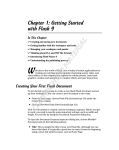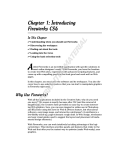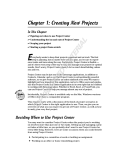Download Wiley Microsoft Office Project 2007 All-in-One Desk Reference For Dummies
Transcript
Chapter 1: Understanding Project Server AL In This Chapter Discovering Project Server RI Determining whether you need Project Server TE Planning the implementation of Project Server B TE D MA ecause you’re reading this book, we can safely assume that the products or services your organization provides are best accomplished in a project environment. We can also safely assume that you have a limited staff available to complete all your projects. In an organization where most of the work happens in a project environment using the same resources, the organization needs to manage the management of projects to maximize productivity and profit. RI GH Enter Project Server. Project Server answers the needs of an enterprise to manage multiple projects that draw their resources from a common resource pool. This chapter describes the basics of how Project Server functions and how to approach using Project Server. PY What Is Project Server? CO Project Server provides your organization with one central database, located on a Web server or in a server farm on your company’s local area network (LAN) or intranet, in which you store all projects and all resources for your organization. Using Project Server, you can ✦ View a project’s Gantt chart ✦ Enter and view timesheet information ✦ Update assignments with progress and completion information ✦ Send status reports to the project manager ✦ Receive notices about task status ✦ Receive, refuse, and delegate work assignments 638 What Is Project Server? ✦ Manage resource allocation across your organization ✦ Carry out basic issue and risk management ✦ Attach supporting documentation, such as budget estimates or feasibility studies, to a task or project Although Project Server works in conjunction with Project Professional, only project managers need to install Project Professional; the project manager uses Project Professional to create projects using the techniques we’ve described throughout this book. In the Project Server environment, your organization can create projects that use identical custom settings to help you manage projects in a consistent manner because Project Server uses the Enterprise Global template the same way that Project uses the Global.mpt template file. The Enterprise Global template contains all the fields, maps, views, tables, reports, filters, forms, groups, and calendars that are stored in the Global.mpt template file that’s included in Project Professional, along with additional enterprise-only fields. You can define whether fields are required, and you can create look-up tables and value lists for fields. In addition to setting up the Enterprise Global template, use Project Professional to create a resource pool that contains all the resources available in your entire organization using the same techniques described in Book III, Chapter 4. Because the resource pool contains all the resources available in your entire organization, it’s aptly named the Global Resource Pool in Project Server. You then publish (that’s “upload” in Project Server lingo) the resource pool and all the organization’s projects to the Project Server database. To work with the information in the Project Server database, you can use Project Professional or Project Web Access, an Internet Explorer browser-based client-side interface that installs when you install Project Server. Figure 1-1 shows you a typical home page in Project Web Access. The way in which you use the Project Server database depends on your role in your organization, because different people have different needs for project information. For example, project team members can use Project Web Access to see the assignments that they’ve received, enter time spent on various project tasks, update work assignments, send status reports to the project manager, and even set up to-do lists. Chapter 4 of this minibook describes how a team member might use the Project Server database. Project Server can exchange information with Outlook. Resources can import tasks from Project Server and export work information from Outlook to Project Server. What Is Project Server? 639 Book X Chapter 1 Understanding Project Server Figure 1-1: A typical Project Web Access home page. Project managers can receive updates to tasks and status reports from team members. Project managers also can use the Global Resource Pool when assigning resources while setting up new projects or tasks within an existing project. The Global Resource Pool helps project and resource managers avoid overallocating resources and also contains a matching feature you can use to match the skills you need for a task to a person in the resource pool with those skills. Chapter 3 of this minibook describes how a project manager might use the Project Server database. Clearly, security becomes a serious issue when you decide to place all the information about your organization’s work into a central repository. Not only do you need to secure the LAN or intranet from the outside world, but you also need to secure the various projects within the Project Server database because everybody doesn’t need to see everything. In fact, two team members working on the same project might need access to different information. Along with other jobs, the Project Server administrator sets up the Project Server database security. The Project Server administrator doesn’t typically decide that John gets to see financial data and Mary doesn’t; instead, the Project Server administrator works with others within the organization to develop security profiles that describe the varying levels of security needed in your organization. And, the Project Server administrator 640 Do You Need Project Server? sets up new users in the Project Server database with the privileges that organization management deems appropriate. The next chapter of this minibook describes the role of the Project Server administrator in more detail. Do You Need Project Server? You might have been managing multiple projects for a long time now, and you might have been managing them effectively, too. So, the question might arise, “Do I really need Project Server?” To determine whether Project Server can help you, ask yourself the following questions: ✦ Has your organization identified a need to track projects more accurately or use resources more efficiently? ✦ Does your organization manage many different projects using the same resources? ✦ Has your organization determined that the time of project managers and resources would be used more efficiently if resources could record their time directly in the project schedule instead of providing it to the project manager, who then updates the schedule? ✦ Do your users need access to project data anywhere in the world? If you answered yes to any of these questions, Project Server can help you. The more “yes” answers you gave, the more likely it us that your organization can benefit from using Project Server. Planning the Implementation of Project Server To successfully implement Project Server, you need to plan for the needs of your organization. You need to assess where your organization is today and where it plans to go. You need to identify the players, their needs, and their roles in the process. You need to figure out what needs to be done, who has the skills and availability to do it, when it needs to be done, and what else depends on it getting done. To summarize, implementing Project Server is a project. You should treat it as such, identifying the tasks that you need to accomplish, estimating the work needed to accomplish them, identifying task dependencies, and assigning resources to the tasks. Planning the Implementation of Project Server 641 To successfully implement Project Server, you should treat the project the same way you would treat an information technology project. You should assess requirements, design the system, and develop an implementation strategy. Defining requirements When you assess requirements for an information technology project, you focus on determining your organization’s direction and needs; the Project Server design ultimately depends on the information that you gather. The team needs to set milestone dates and task durations for each of the following activities: ✦ Identify the people who will approve the Project Server design ✦ Identify staff members to interview ✦ Create a requirements definition questionnaire ✦ Conduct interviews ✦ Calculate return on investment As with any project, it’s important to identify the decision-makers as soon as you start. If possible, include one or more of them on the team so that they are a part of the process and they feel ownership for the system that you ultimately design. For interviews, identify staff members who fill the following roles: ✦ Administrators: People who manage changes and access to the Project Server database. The people who start the administrator job might ultimately phase out of the job because the job functions change over time. Initially, the administrator installs and sets up Project Professional, Project Server, and SQL Server and may use both Project Server and SQL Book X Chapter 1 Understanding Project Server On the team you set up to implement the system, you need people who are good at gathering information, making design decisions, and managing implementation. You’ll find it helpful to include people who are experienced in using enterprise project management systems. You need a mix of business people and technical people to address the various facets of implementing Project Server. The business people should include senior project managers and staff with experience using Project. The technical people should include those who are experienced in your company’s network architecture and hardware configuration. To customize or automate Project Server functions, you should include a technical person with skills in developing object models for Project. Everyone on the team should be familiar with your company’s standards. 642 Planning the Implementation of Project Server Server tools to meet the needs of users. Eventually, the administrator role migrates to a maintenance function, where knowledge of Project Server administrative functions is the only prerequisite. ✦ Executives: People who view reports on projects and resources. ✦ Portfolio managers: People who are familiar with company standards and can manage the Enterprise global template. ✦ Project managers: People who prepare project plans and monitor project progress. ✦ Resource managers: People who delegate work to team members and monitor project progress and resource utilization. ✦ Team members: People to whom work is assigned. To effectively interview, the team should create a questionnaire that focuses on obtaining information about how people work. To gather information for your questionnaire, evaluate the reports that your company currently uses to record project performance. Analyze these reports to identify the resources and projects that are or should be included on the report. Evaluate how tasks, projects, and resources are categorized on the reports and note who uses each report. When you conduct interviews, make sure that you include more than one person in each role because two people filling the same role do things differently and potentially have different needs. Implementing Project Server will require software and role-based training for resources, and it might also require investments in hardware. Because of the investment required to implement Project Server, you should calculate your return on investment to assess the costs and benefits of implementing Project Server. Designing the system Using the information that you gathered while defining requirements, you should be able to identify the features in Project Server that you want to implement. In addition, the implementation team must also address issues that aren’t directly related to the design of the Project Server database. For example, the team should ✦ Evaluate the technology environment ✦ Address special needs ✦ Establish and/or enforce organizational standards ✦ Plan for training Planning the Implementation of Project Server 643 The team must evaluate the organization’s technology environment because Project Server requires certain software, and the hardware that you use affects the performance of Project Server. The requirements definition might highlight some special needs. For example, your organization might want to use Windows SharePoint Services, which comes with Project Server, to build and maintain document libraries for projects and deal with issues in a collaborative way. We can’t stress strongly enough how important training is. Suffice it to say that without proper training for those who will use Project Server, implementation will fail. Developing an implementation strategy Because the scope of implementing enterprise project management affects your entire organization, doing it “all at once” is very risky. Using a phased approach reduces the risk considerably and increases your chances for success. Start by creating a prototype of the system. Identify a few projects and project teams to participate in the prototype test, making sure that you select users who represent all the various roles that the team identified so that you can fully test the system. Also, select projects that don’t depend on other projects that won’t be a part of the prototype. Design and develop the prototype system and demonstrate it to the project teams that will use it. Make modifications to the prototype design based on input from these project teams and demonstrate the prototype to senior management, once again, making changes as needed. Then develop training materials and begin a pilot phase. Reset the Project Server database and load the pilot projects that include users who represent all the various roles that the team identified. During this pilot phase, you should include at least one project that has external dependencies to another project to test that aspect of using Project Server, and then you can make adjustments as needed. Train the pilot group and allow the group members to use Project Server for at least four reporting cycles. Solicit feedback and address all the issues that arise. Book X Chapter 1 Understanding Project Server The team should customize the Enterprise Global template to reflect the standards of your organization so that everyone uses the same terminology and applies the same processes and procedures to their projects. In the Enterprise Global template, you can create custom fields, outline codes, views, and calendars. The team can also set up the Enterprise Resource Pool so that your organization can share resources between projects and identify conflicts between assignments in different projects. 644 Planning the Implementation of Project Server When you’re satisfied that you’ve ironed out any kinks identified during the prototype and pilot phases, expand the user base of the system again, adding projects to the Project Server database, and train the new group that is to begin using the system. Allow each new group of users to work through at least three reporting cycles before you add more projects and users. Reviewing software needs As you’d expect, Microsoft has established certain basic software and hardware requirements needed to support Project Server. On the software side, you need to meet requirements for both client machines and server machines. Client machines used by the project manager need Project Professional and Internet Explorer 6.0 or higher. The client machines of other resources need only Internet Explorer 6.0 or higher. And, if you intend to exchange task information with Outlook, client machines also need Outlook 2007. Servers that will host Project Server need, at a minimum, Windows Server 2003, Standard or Enterprise Edition, 32-bit or 64-bit, with Service Pack 1 or later. You need to enable Microsoft Internet Information Server (IIS) 6.0 or above, and for the Project Server database engine, you need SQL Server 2000 with Service Pack 3 or higher or SQL Server 2005. If you want to use the portfolio modeling features that are available in Project Web Access, you need SQL Server Analysis Services and SQL Server Reporting Services, which are included with SQL Server but must be installed separately. In addition, Project Server depends on the Windows SharePoint Services 3.0 (WSS) platform, which comes on the Project Server 2007 CD and installs automatically when you install Project Server. To use e-mail notifications, both the server and client machines need Internet SMTP/POP3, IMAP4, or MAPI-compliant messaging software. Reviewing hardware needs Microsoft recommends that each client machine have, at a minimum, a 300-MHz processor, have 192MB of RAM, and use Windows XP Professional as the operating system. The minimum processor on a client machine is a Pentium 133-MHz. Each client machine should have a Super VGA (800 x 600) or higher resolution monitor with 256 colors and a Microsoft Mouse– compatible pointing device. Typically, you install Project Server on your company’s server or in a server farm. If you’re planning to use the bare-minimum hardware, you should load only Project Server on that computer. Other components, such as SQL Server, should run on separate computers to help you balance the load. You can read more about load balancing in the next section. Planning the Implementation of Project Server 645 Microsoft recommends that you install Project Server on a computer with a minimum Pentium III processor that runs at 700 MHz and has 1GB of RAM, a DVD-ROM drive, a Super VGA (800 x 600) or higher resolution monitor, and a Microsoft Mouse–compatible pointing device. To install Project Server, you need 200MB of available hard drive space. To install WSS, you need another 70MB of hard drive space and a minimum of 256MB of RAM, but 512MB of RAM is recommended. To install SQL Server 2000, you need 250MB of hard drive space and 128MB of RAM. If you also intend to install SQL Analysis Services, you need another 130MB of hard drive space and another 128MB of RAM. Considering software and hardware configurations The overall performance of Project Server is affected by the features of Project Server that you want to use, the total number of users and concurrent users, and the number of projects that you want to store in the Project Server databases. As you read earlier in this chapter, you’re loading a lot of software to use Project Server. But, because Project Server 2007 depends on Windows SharePoint Services 3.0, you have some choices about how you configure the hardware on which you will load the software, and your choices will affect the performance of Project Server. You can use a single server or a server farm. If you use a single server, you load all the software that Project Server needs to run onto that one server. But, if you choose to use a server farm, you can place various components and services on several networked computers to balance the load. The server farm has a few advantages. Using a server farm improves your ability to easily expand to meet growing needs while simultaneously limiting the impact created when a single component or service fails. You can set up Project Server 2007 in a small farm, a medium farm, or a large farm. There are many ways that you can set up each server farm size, and Microsoft makes some recommendations about the various server farm configurations. In each of these configurations, Microsoft classifies the servers Understanding Project Server You might want to plan to upgrade your network infrastructure. The amount of traffic that you can expect on your network is directly related to the total number of users, the number of concurrent users updating the Project Server databases, and the number and size of projects that you store in the Project Server database. Using older network architecture (10Base-T) in a heavily trafficked environment will undoubtedly result in complaints that the system is slow. Book X Chapter 1 646 Planning the Implementation of Project Server in the farm as Web front-end servers, application servers, and SQL servers and recommends placing different components of Project Server on the different classifications of servers. Typically, here’s how things work: ✦ You place Windows SharePoint Services and Project Web Access on Web front-end servers. ✦ You put applications such as the Project Server Interface, Project Server business objects, and Project Server reporting and queuing services on application servers. ✦ You place Project Server SQL databases, SQL Analysis Services, and SQL Reporting Services on SQL servers. In a small server farm, you load everything on two servers. You designate one computer as the SQL Server, placing SQL 2000 or SQL 2005 and SQL Analysis Services and SQL Reporting Services on that computer. Then use the other computer as both a Web front-end server and an application server, where you install Project Server and Windows SharePoint Services. This configuration separates database processing from other processing and typically improves performance. In a medium server farm, you use three tiers of servers, installing each Project Server component in a separate Web front end, application, and database server tier. This approach works well when you need to accommodate more users because you can add more Web front-end servers, application servers, and, if necessary, database servers. In the large server farm configuration, you use three tiers and install each component in a separate tier like you do in the medium server farm. In the large server farm configuration, you might also be using other services available through SharePoint Server 2007, such as Search, Index, or Excel Calculation Services. In this case, you set up each of these services on its own server.























